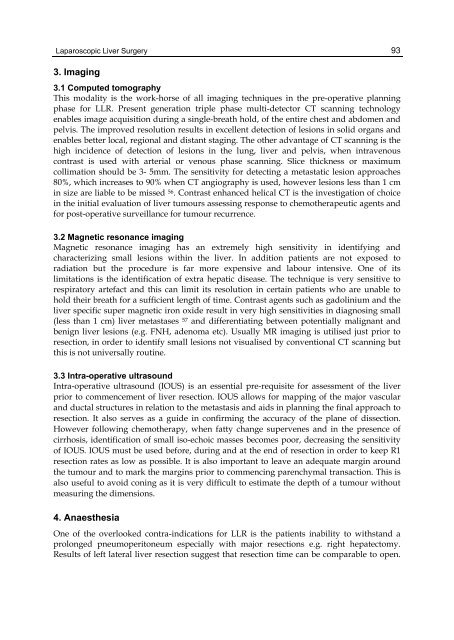UPDATED TOPICS IN MINIMALLY INVASIVE ABDOMINAL SURGERY
UPDATED TOPICS IN MINIMALLY INVASIVE ABDOMINAL SURGERY
UPDATED TOPICS IN MINIMALLY INVASIVE ABDOMINAL SURGERY
You also want an ePaper? Increase the reach of your titles
YUMPU automatically turns print PDFs into web optimized ePapers that Google loves.
Laparoscopic Liver Surgery<br />
3. Imaging<br />
3.1 Computed tomography<br />
This modality is the work-horse of all imaging techniques in the pre-operative planning<br />
phase for LLR. Present generation triple phase multi-detector CT scanning technology<br />
enables image acquisition during a single-breath hold, of the entire chest and abdomen and<br />
pelvis. The improved resolution results in excellent detection of lesions in solid organs and<br />
enables better local, regional and distant staging. The other advantage of CT scanning is the<br />
high incidence of detection of lesions in the lung, liver and pelvis, when intravenous<br />
contrast is used with arterial or venous phase scanning. Slice thickness or maximum<br />
collimation should be 3- 5mm. The sensitivity for detecting a metastatic lesion approaches<br />
80%, which increases to 90% when CT angiography is used, however lesions less than 1 cm<br />
in size are liable to be missed 56. Contrast enhanced helical CT is the investigation of choice<br />
in the initial evaluation of liver tumours assessing response to chemotherapeutic agents and<br />
for post-operative surveillance for tumour recurrence.<br />
3.2 Magnetic resonance imaging<br />
Magnetic resonance imaging has an extremely high sensitivity in identifying and<br />
characterizing small lesions within the liver. In addition patients are not exposed to<br />
radiation but the procedure is far more expensive and labour intensive. One of its<br />
limitations is the identification of extra hepatic disease. The technique is very sensitive to<br />
respiratory artefact and this can limit its resolution in certain patients who are unable to<br />
hold their breath for a sufficient length of time. Contrast agents such as gadolinium and the<br />
liver specific super magnetic iron oxide result in very high sensitivities in diagnosing small<br />
(less than 1 cm) liver metastases 57 and differentiating between potentially malignant and<br />
benign liver lesions (e.g. FNH, adenoma etc). Usually MR imaging is utilised just prior to<br />
resection, in order to identify small lesions not visualised by conventional CT scanning but<br />
this is not universally routine.<br />
3.3 Intra-operative ultrasound<br />
Intra-operative ultrasound (IOUS) is an essential pre-requisite for assessment of the liver<br />
prior to commencement of liver resection. IOUS allows for mapping of the major vascular<br />
and ductal structures in relation to the metastasis and aids in planning the final approach to<br />
resection. It also serves as a guide in confirming the accuracy of the plane of dissection.<br />
However following chemotherapy, when fatty change supervenes and in the presence of<br />
cirrhosis, identification of small iso-echoic masses becomes poor, decreasing the sensitivity<br />
of IOUS. IOUS must be used before, during and at the end of resection in order to keep R1<br />
resection rates as low as possible. It is also important to leave an adequate margin around<br />
the tumour and to mark the margins prior to commencing parenchymal transaction. This is<br />
also useful to avoid coning as it is very difficult to estimate the depth of a tumour without<br />
measuring the dimensions.<br />
4. Anaesthesia<br />
One of the overlooked contra-indications for LLR is the patients inability to withstand a<br />
prolonged pneumoperitoneum especially with major resections e.g. right hepatectomy.<br />
Results of left lateral liver resection suggest that resection time can be comparable to open.<br />
93














![focuspdca.ppt [Compatibility Mode]](https://img.yumpu.com/22859457/1/190x146/focuspdcappt-compatibility-mode.jpg?quality=85)


